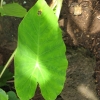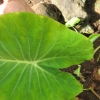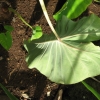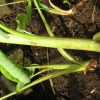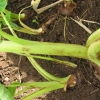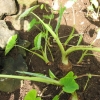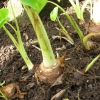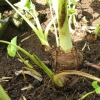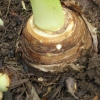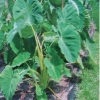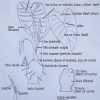Use As Food
Makes poi of good quality. The time of cooking is often twice as long as for other varietics. A fragrant odor (‘ala) is usually emitted when the ‘i‘o kalo (Corm) are cooked: hence the name ‘Ala is sometimes used, instead of Kāī, for this group.
Distribution
Found only occasionally, almost exclusively under wetland culture, usually associated with Kāī Kea. Observations seem to indicate that the Kāī varieties are more tolerant of alkaline conditions than any other group, and of stagnant water. They are also tolerant of deep or soft patches whereas most varieties require a firm, relatively shallow soil. There is evidence that Kāī are more resistant to soft rot.
General Characteristics
Medium in height, well spreading, maturing within 8 to 12 months, producing from 5 to 10 ‘ohā; identified by widely spreading light yellowish-green to almost whitish Hā (Petiole).
Ha (Petiole)
75 to 90 cm. long, light yellowish-green to whitish, distinctly reddish at edge, brownish at the top (apex), a white or faint cream-colored ring at kōhina (base) with white for about 3 cm. above the base.
Lau or Lu'au(Leaf Blade)
45 to 55 cm. long, 30 to 40 cm. wide, 35 to 45 cm. from tip to base of sinus (māwae), egg-shaped (ovate), concave (curve inward), pendant, light green; margins with numerous fine undulations, the marginal veins hard and crisp in texture; piko yellowish to light brownish; round leaf section (lobes) obtuse with narrow lihi māwae (sinus).
'I'o kalo (Corm)
Flesh white with yellowish fibers; skin cream-colored.
Pua (Flower)
Hā (peduncle) whitish; flower cover (spathe) 19 to 22 cm. long, the lower constricted portion 3 to 4 cm. long, light green, the upper portion light yellow, somewhat open; spadix (spike of flower) 7 to 9 cm. long, the sterile appendage (tip of flower's spike) 7 to 10 mm. long.
Remarks

